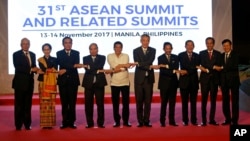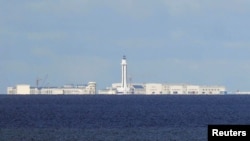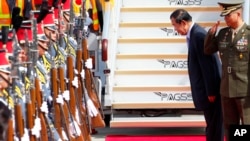A draft statement to be issued on the final day of the Association of Southeast Nations (Asean) shows the bloc is reluctant to take a strong stance against China over the South China Sea dispute after Philippines President Rodrigo Duterte, who hosted the summit over the weekend, said now was not the time to address the issue.
Two paragraphs of the statement, obtained early by VOA Khmer, mention freedom of navigation and security in the region without referring to the South China Sea directly.
“We underscored the importance of strengthening linkages in maritime cooperation to further promote mutual trust and confidence to ensure security, peace, and stability including in ensuring safety and freedom of navigation and overflight,” it says.
“We reaffirmed the shared commitment to maintaining and promoting peace, security, and stability in the region, as well as to the peaceful resolution of disputes, including full respect for legal and diplomatic processes, without resorting to the threat or use of force, in accordance with the universally recognized principles of international law,” it adds.
Disputes over sovereignty in the South China Sea have emerged as one of the biggest security threats in the region over the past decade. As China has has become a world power, making assertive claims to a large swath of the energy-rich sea, which has significant strategic and commercial importance.
U.S. allies Japan and South Korea use the sea's shipping lanes, over which about $5 trillion in trade passes annually. China has reinforced its claims to the sea with the construction of artificial islands, which the United States and others have criticized.
In recent years, Asean has been split between members like Vietnam and the Philippines, which want to hash out these disputes as a regional bloc, and those like Cambodia, which want every affected country to negotiate individually with China. This is also the position taken by Beijing, which has insisted it will only engage in bilateral talks over these arguments.
Cambodia emerged as a leader of the pro-China bloc in Asean when it hosted the annual summit in 2012 and blocked attempts to release a strongly worded statement on the issue. Many interpreted the incident as a China-led effort to undercut regional unity and strengthen its own position. It was the first time in ASEAN’s history that its leaders could not agree on the wording of a joint statement.
At last year’s Asean summit in Laos, Cambodia also reportedly stymied efforts to release a statement on the issue, refusing to sign anything that mentioned the Philippines’ 2016 victory at the Permanent Court of Arbitration over its claims to part of the sea.
Prak Sokhon, Cambodian foreign minister, said in September that the country’s main goal was to find a peaceful resolution to the dispute while maintaining its neutrality.
Leaders at this year’s summit are expected to discuss the long-awaited code of conduct for the sea, which was finalized earlier this year by Chinese and Asean leaders.
Chheang Vannarith, a regional analyst, said Asean was retreating from taking forthright action over the South China Sea. “The Philippines chair has been reluctant to push the agenda on the South China Sea in order to gain trust from China as well as economic incentives,” he said.
“They are diversifying their strategic and economic partners away from the US under Trump.”
Peter Maguire, a law professor and Southeast Asia observer, said the “abysmal failure” of former President Barack Obama’s Pivot to Asia strategy and Trump’s “unhinged rhetoric” and decision to drop the Trans-Pacific Partnership trade deal had left the United States looking weak and “confused” in the region.
“China’s Asia Infrastructure Investment Bank and their Belt and Road Initiative have left few doubts as to who is the region’s shotcaller. America’s unipolar moment was short lived and now the bill is due for our imperial overstretch,” he said.
“With the exception of Vietnamese waters, China already has de facto control of the South China Sea and most of the ASEAN nations seem resigned to this. America’s Freedom of Navigation operations are little more than a symbol show of force.”
The draft statement to be issued at the end of this year’s summit said: “The Leaders agreed to continue to build confidence through practical maritime cooperation. They adopted the Leaders’ Declaration on a Decade of Coastal and Marine Environmental Protection in the South China Sea, which is reflective of their shared commitment to the full and effective implementation of the DOC.”
Meanwhile, some 800 civil society representatives from Asean’s 10 member states and Timore-Leste met Asean leaders in Quezon City, north of Manila, to discuss broadening access to human rights in the region.
Thida Khus, executive director of Silaka, a Cambodian rights group, said the civil society groups would produce their own statement to submit to the forum, raising issues around indigenous peoples, democracy, transparency of investment and development and the rule of law.
In the draft Asean statement, its chairman said the grouping was committed to promoting the rights of migrant workers.
Phil Robertson, deputy director of Human Rights Watch’s Asia division, said: “I think it is very important that we have this Asean peoples forum to reflect the voices of the people, of Asean, of civil society, the community voices because those voices are not heard by their governments in many cases.”












